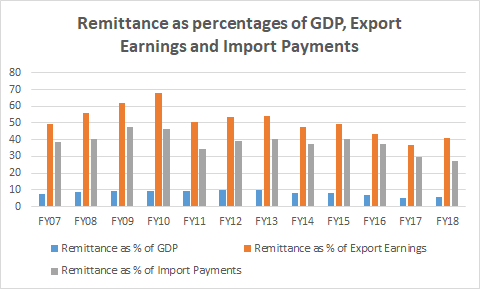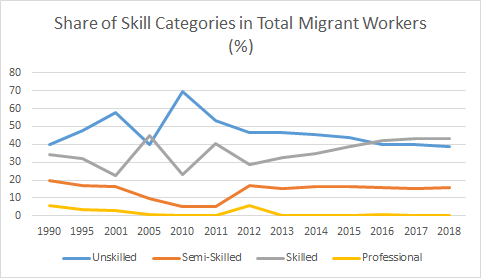GET IN TOUCH
- Please wait...

Remittance from foreign labourers is the second highest source of foreign currency earnings for Bangladesh. However, since a major portion of the earnings from the highest source, i.e., RMG, is spent buying raw materials, remittance (in other words, the earnings from the foreign labour market for Bangladeshis) is the largest source of net foreign earnings.[1]
Globally, Bangladesh secured the 9th highest position in remittance earnings for 2018.[1] Remittance was the source of 40.86% of export earnings and 27.51% of import payments in FY18.[1]

About 77% of the total remittance earnings come from the Gulf Countries which include the Kingdom of Saudi Arabia (KSA), UAE, Qatar, Oman, Bahrain, and Kuwait.[2] This indicates that the Bangladesh economy is highly dependent on these countries to sustain its foreign earnings. Thus, if remittance inflow from these countries declines for any reason, it will cause a significant blow to the Bangladesh economy.
Though a large portion of Bangladeshi laborers are unskilled/semi-skilled, the number of skilled workers has recently been on the rise.[1] The major competitors of Bangladesh in the foreign labor market include India, Sri Lanka, and the Philippines.[3]
| Countries | Key Characteristic |
| India | A major source of IT professionals |
| The Philippines | A popular source of skilled labourers due to well-developed training programs. |
| Sri Lanka | Sri Lanka supplies 80% of the unskilled labourers to the Gulf Countries |
Despite the fact that the foreign labor market for Bangladeshis is a major driver in the economy of Bangladesh, some significant issues are plaguing it.
Bangladeshi labourers in the Gulf Countries have regularly been victims of exploitation and mistreatment by their employers. When 110 returnees were interviewed, it was found that 86% did not receive their full salaries, 61% were physically abused, 24% were deprived of food, and 14% were sexually abused by their employers.[5]
According to BRAC, 1,353 female workers came back to Bangladesh from Saudi Arabia in 2018 citing inhumane working schedules and conditions.[6]
A major culprit in the exploitation of Bangladeshi workers in the Gulf Countries is the Kafala System which enables employers to sponsor the visas of immigrant workers in exchange for taking away their ability to bargain wages.[7]
While Qatar banned this system in 2019, it is still in practice in the other Gulf Cooperation Council (GCC) countries. Apart from the GCC countries, Jordan and Lebanon also practice this system.[8]
Given Bangladesh’s high dependency on Gulf countries for the majority of remittance earnings, the country has little bargaining power when it comes to protecting the rights of its workers. Moreover, Bangladesh is at the mercy of the regulators of these countries to allow Bangladeshi workers.
For example, the UAE has banned Bangladeshi labourers since 2012.[9] Kuwait had also barred Bangladeshi workers between the years 2006 to 2014. Another ban on VISA 20 or the Visa for domestic servants was imposed in the year 2018.[10] Moreover, Saudi Arabia, the biggest destination for Bangladeshi workers has enforced a Saudization policy which looks to reduce its dependence on foreign workers.[11]
Bangladesh’s only resort against these regulations and policies is confined to requesting the respective governments to lift them.
A significant portion of the migrant workforce gains work permits and other documents through illegal sub-agents (dalals) or intermediaries.[12] These often lead them to use illegal and potentially dangerous channels of migration.[13]
In fact, only 10% of Bangladeshi workers migrate through formal channels which leads to them falling victim to fraudulent middlemen and exploitative employers, leading to the loss of their life savings and assets while facing harassment, abuse, and imprisonment.[14]
Migrant workers resort to these channels because the official channels are more expensive and there is no scope for migration on a regular basis.[12]
While Bangladesh has a sizeable number of skill development institutions, they are not well-coordinated. This raises questions about the quality of the certificates they provide and their students often do not gain the required skills.[15]
Migrant workers are classified into four categories: Professionals (doctors, engineers, nurses, teachers, etc), Skilled (garments workers, manufacturing workers, electricians, etc), semi-skilled (tailors, masons, etc), and unskilled (housemaids, cleaners, labourers, etc).[16]
Historically, the percentage of unskilled workers has always been higher than skilled workers. However, this scenario has changed recently. As of 2018, 43.25% of the workers were skilled as opposed to 38.55% unskilled.

This is a very encouraging trend because it will help Bangladesh concentrate on countries outside the Gulf since there is a demand for skilled workers all over the world. Historically, Bangladesh has been lagging behind its competitors due to a lack of skilled workforce. As of 2018, for every $100 earned by a Bangladeshi worker, an Indian worker would earn $200 and a Sri Lankan would earn $300.[18]
The demand for skilled workers is increasing in other parts of the world as well. Japan will take 334,000 workers in the next five years from eight countries including Bangladesh.[19] To compete with the other seven countries and make full use of this opportunity, Bangladesh will have to increase its supply of skilled workers.
Europe is facing a demographic decline which will result in its working population dropping by 10% or 1.9 million by 2020. Currently, India is looking to fill up that gap, mainly with their huge force of IT skilled workers.[20] The Bangladesh IT sector is growing and is expected to reach around US$4.8 billion by 2025.[21] Thus, Bangladesh can also look to take a bite out of this market in Europe.
Germany passed a law on June 2019 to allow skilled migrants into the country. The federal government of Germany predicts that this law will bring 25,000 skilled workers to Germany every year.[22]
While Bangladesh has been reaping the benefits of the remittances of unskilled and semi-skilled labourers, it is now time to take the next step and enter the market of skilled workers. While countries like India and the Philippines have already made strides in the skilled labour market, it is not necessarily a disadvantage for Bangladesh.
Bangladesh can use their cases as models to build its own infrastructure to fulfill the demand for skilled labour in the world.
To develop skilled workers, it is necessary for the population all over the country to have access to training centers. This will require activities from both Public and Private organizations. However, the Bangladesh Technical Education Board (BTEB) and the Bureau of Manpower, Employment, and Training (BMET) should have centralized control over the content of the courses to ensure they meet international requirements.
The remittance sent by the low-skilled migrant workers has been a driver of the economy of Bangladesh for a very long time. As Bangladesh is transitioning to a middle-income country from a low-income country, it is time for the migrant worker industry to transition to its next phase and concentrate on producing skilled labourers.
Kidwa Arif, Trainee Consultant at LightCastle Partners, has prepared the write-up. For further clarifications, contact here: [email protected].
Our experts can help you solve your unique challenges
Stay up-to-date with our Thought Leadership and Insights